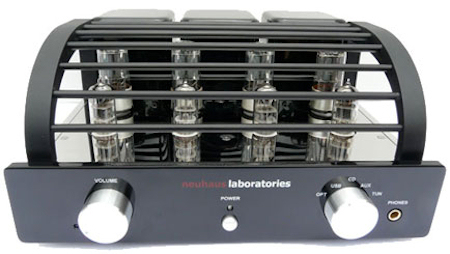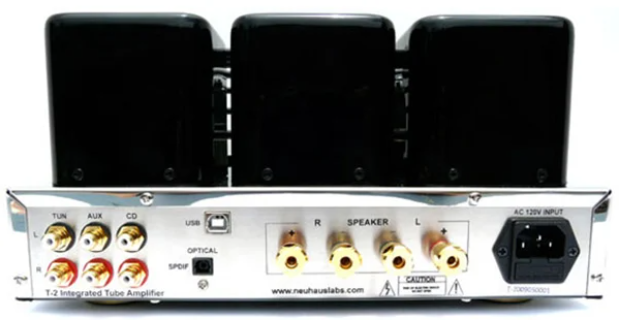Valve Amp for the Audiophile
There’s a lot of buzz on the popular, tech blogs about the new T-2 amplifier from Neuhaus Labs. It’s built on vacuum tubes and hand-wound transformers. I’ve got about 14 years [at the time of writing this post] in the Pro Audio and Video manufacturing industries, so naturally, I was very curious to look at the T-2. Short answer: It’s a WIN! Here’s my opinion.

At $800 $795, it’s too expensive for me to pick up and try out. Though, you can buy it and send it back in 15-days if it sucks. The return policy is an indication that the manufacturer has faith in their product. So I just have to settle for looking at the pretty pictures. I’d love to see the schematic and bill of materials for this amp. It seems well constructed. I recognize some of the typical higher quality components such as the bolt-on gold-plated phono connectors (excellent choice). Also, the case has a very typical but well-thought-out kind of construction suitable for quick and sturdy assembly. The grill over the tubes is a nice touch. Seems somebody at the factory actually knows what they’re doing. Attach a chain and use it as a mace for home defense; it’ll still function afterward (unless you get blood in the circuits).

But look, there’s no UL, CSA, CE, etc. Well, those things are really expensive to get, but could also indicate a fire hazard. UL won’t Ok those home deep-fryers for frozen turkeys either. Warning: Do not attempt to deep-fry a frozen turkey. They’re not going to sell in Europe without a CE declaration of conformity. But who cares? This is America, and this amp was made in America; probably by actual Americans working in a very small factory without good air-conditioning or incandescent lighting.
More importantly, the specifications get my goat; I’m not kidding either. On one of their pages, Neuhaus Labs talks about what kind of wattage your getting when compared to cheap mass-produced plastic crap:
Watts on a transistor amp are cheap. You can buy a 100-watt receiver for a few hundred dollars at an electronics outlet. The wattage ratings of the typical big name amplifier tell you nothing about how the amplifier really sounds when it plays music. While a transistor amplifier may have higher watts, a well-designed tube amplifier will just sound better.
I completely agree with that statement. So why does the T-2 Amp rate its power output at a mere 20-Watts per channel. 20-Watts of what? RMS, Peak-to-Peak, PMPO. Oh, it better not be PMPO. Why? Kinyo “200 W” PC speakers: 3 W RMS = 200 W PMPO. I’d like to see that spec in RMS. It’s probably 20-Watts RMS in reality, which would be really quite loud, and it’s what I would expect for my $800 $795. Some other things I like to see in the specifications are:
- Input Level. Stupid question, but I just want to be sure it’s really -10dBv.
- Frequency Response is 10Hz – 30kHz, (nice) but should include at +/- dB tolerance at what output impedance.
- Total Harmonic Distortion plus Noise (THD+N).
- Common Mode Rejection Ratio (CMRR).
- Crosstalk.
- Warm up time.
Something I would really want to know about is the Jitter issue since we’re mixing digital and tube. Even high-quality electronics with digital inputs/outputs will sometimes lose their signal integrity to jitter. Usually, anti-jitter circuits take care of this; even then, the device sometimes just has to be reset. I would want to know if there are any anti-jitter circuits, jitter buffers, or what-not. Especially considering that turning a tube device off and on over and over is usually not the best idea. Are the high-quality tube circuits complemented with high-quality digital electronics?
Only for the Audiophile. Not for the MP3 collector. Most tube junkies whine and bitch about transistor noise, circuit coldness, and hate CDs like Apple users hate Bill Gates (sorry Bill, it’s the truth). Most of it is simply a cult factor, and there’s no reasoning with anyone who spends $350,000 on a stereo system. Ok, there’s something to be said for the warmth of random electrons straying through the tube grid, and it does make a perceivable difference that can affect one’s perception of music. If I was listening to high quality, fully uncompressed philharmonics, then “Hell Yeah”, give me this tube amp.
BTW, great Audiophile article by Gizmodo: Why We Need Audiophiles.
But I’m disgusted by some of the reviews I’ve read written by people who bought this T-2 amp and used it solely to listen to music they got from iTunes. OMG, WTF? The crap that comes out of iTunes is so compressed, that you can’t even hear drum symbols; all the high frequencies are gone. Using a T-2 to enjoy over-compressed digital media is a lot like owning a Harley and then towing it from town to town. What’s the point of sitting on a Harley and looking cool (besides picking up biker chicks)? The real fun is in the ride. But who am I to judge? I’m Dr. Warthan, that’s who. Using a tube amp to listen to iTunes poop makes you guilty!
Another BTW, Napster is was THE place to get MP3s. I’ve personally tested and compared iTunes, Napster, and all the others against a CD source to find out who was the best. Napster was the only one to provide an MP3 that sounded better than the CD. Their MP3s are uncompressed, not VBR’d, not DRM’d, and their bit rate is 256kbps (CDs are only considered to be 192kbps).
Final word: Go ahead, get it. But if you do, I hope you at least have a turntable, a few vinyls, and some decent speakers. Get four of them and make yourself a 7.1 surround setup. 🙂 And if you find a subwoofer that runs on 20-Watts, let me know.
Tags: 20, Amplifier, Audio, Audiophile, CD, Cool, iTunes Sucks, Nice, Phono, Quality, Sound, Stereo, T-2, Tube, Valve, Watts, Win